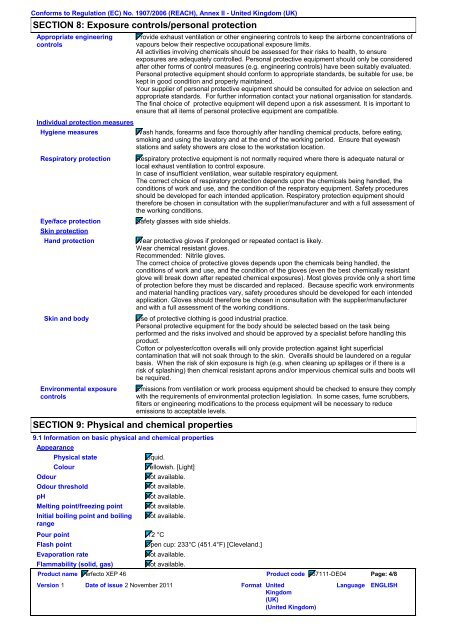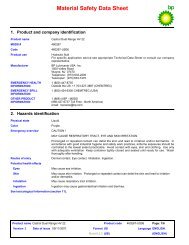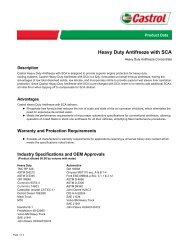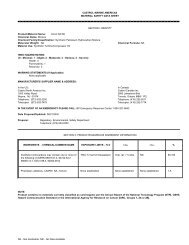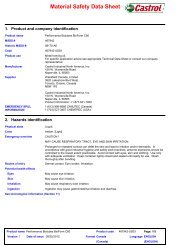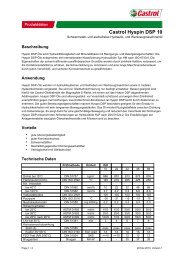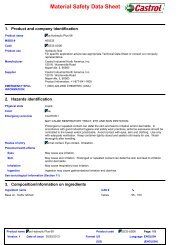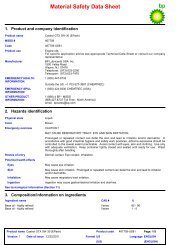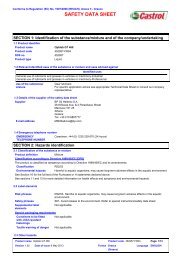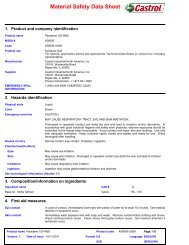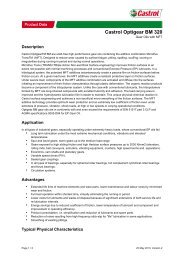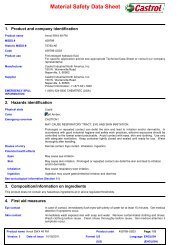067987Perfecto XEP 46.pdf - Castrol - PDS & MSDS Search
067987Perfecto XEP 46.pdf - Castrol - PDS & MSDS Search
067987Perfecto XEP 46.pdf - Castrol - PDS & MSDS Search
Create successful ePaper yourself
Turn your PDF publications into a flip-book with our unique Google optimized e-Paper software.
Conforms to Regulation (EC) No. 1907/2006 (REACH), Annex II - United Kingdom (UK)<br />
SECTION 8: Exposure controls/personal protection<br />
Appropriate engineering<br />
controls<br />
Individual protection measures<br />
Hygiene measures<br />
Respiratory protection<br />
Eye/face protection<br />
Skin protection<br />
Hand protection<br />
Skin and body<br />
Environmental exposure<br />
controls<br />
Provide exhaust ventilation or other engineering controls to keep the airborne concentrations of<br />
vapours below their respective occupational exposure limits.<br />
All activities involving chemicals should be assessed for their risks to health, to ensure<br />
exposures are adequately controlled. Personal protective equipment should only be considered<br />
after other forms of control measures (e.g. engineering controls) have been suitably evaluated.<br />
Personal protective equipment should conform to appropriate standards, be suitable for use, be<br />
kept in good condition and properly maintained.<br />
Your supplier of personal protective equipment should be consulted for advice on selection and<br />
appropriate standards. For further information contact your national organisation for standards.<br />
The final choice of protective equipment will depend upon a risk assessment. It is important to<br />
ensure that all items of personal protective equipment are compatible.<br />
Wash hands, forearms and face thoroughly after handling chemical products, before eating,<br />
smoking and using the lavatory and at the end of the working period. Ensure that eyewash<br />
stations and safety showers are close to the workstation location.<br />
Respiratory protective equipment is not normally required where there is adequate natural or<br />
local exhaust ventilation to control exposure.<br />
In case of insufficient ventilation, wear suitable respiratory equipment.<br />
The correct choice of respiratory protection depends upon the chemicals being handled, the<br />
conditions of work and use, and the condition of the respiratory equipment. Safety procedures<br />
should be developed for each intended application. Respiratory protection equipment should<br />
therefore be chosen in consultation with the supplier/manufacturer and with a full assessment of<br />
the working conditions.<br />
Safety glasses with side shields.<br />
SECTION 9: Physical and chemical properties<br />
9.1 Information on basic physical and chemical properties<br />
Appearance<br />
Odour<br />
pH<br />
Physical state<br />
Colour<br />
Odour threshold<br />
Melting point/freezing point<br />
Initial boiling point and boiling<br />
range<br />
Flash point<br />
Evaporation rate<br />
Wear protective gloves if prolonged or repeated contact is likely.<br />
Wear chemical resistant gloves.<br />
Recommended: Nitrile gloves.<br />
The correct choice of protective gloves depends upon the chemicals being handled, the<br />
conditions of work and use, and the condition of the gloves (even the best chemically resistant<br />
glove will break down after repeated chemical exposures). Most gloves provide only a short time<br />
of protection before they must be discarded and replaced. Because specific work environments<br />
and material handling practices vary, safety procedures should be developed for each intended<br />
application. Gloves should therefore be chosen in consultation with the supplier/manufacturer<br />
and with a full assessment of the working conditions.<br />
Use of protective clothing is good industrial practice.<br />
Personal protective equipment for the body should be selected based on the task being<br />
performed and the risks involved and should be approved by a specialist before handling this<br />
product.<br />
Cotton or polyester/cotton overalls will only provide protection against light superficial<br />
contamination that will not soak through to the skin. Overalls should be laundered on a regular<br />
basis. When the risk of skin exposure is high (e.g. when cleaning up spillages or if there is a<br />
risk of splashing) then chemical resistant aprons and/or impervious chemical suits and boots will<br />
be required.<br />
Emissions from ventilation or work process equipment should be checked to ensure they comply<br />
with the requirements of environmental protection legislation. In some cases, fume scrubbers,<br />
filters or engineering modifications to the process equipment will be necessary to reduce<br />
emissions to acceptable levels.<br />
Liquid.<br />
Pour point -12 °C<br />
Flammability (solid, gas)<br />
Product name<br />
Version 1<br />
Yellowish. [Light]<br />
Not available.<br />
Not available.<br />
Not available.<br />
Not available.<br />
Not available.<br />
Open cup: 233°C (451.4°F) [Cleveland.]<br />
Not available.<br />
Not available.<br />
Perfecto <strong>XEP</strong> 46 Product code 467111-DE04 Page: 4/8<br />
Date of issue 2 November 2011<br />
Format United<br />
Kingdom<br />
(UK)<br />
(United Kingdom)<br />
Language<br />
ENGLISH


